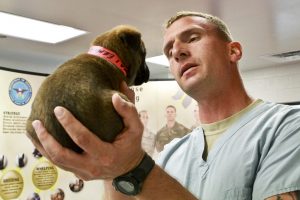 Caveat emptor! This Latin phrase means “Let the buyer be ware.” Whether we get our new puppy or kitten from “Pedigree Pets” or “Poorhouse Pound,” we have nevertheless made a purchase. For if we haven’t committed dollars, we have certainly committed feelings. If an illness surfaces, who of us can return that cute little bundle of fur? Very few, indeed. But what if we’re told there is a heart defect or bone malformation or any other serious problem which will carry through our pet’s life? Then what?
Caveat emptor! This Latin phrase means “Let the buyer be ware.” Whether we get our new puppy or kitten from “Pedigree Pets” or “Poorhouse Pound,” we have nevertheless made a purchase. For if we haven’t committed dollars, we have certainly committed feelings. If an illness surfaces, who of us can return that cute little bundle of fur? Very few, indeed. But what if we’re told there is a heart defect or bone malformation or any other serious problem which will carry through our pet’s life? Then what?
Your veterinarian is best equipped to help you through these decisions. He or she can advise you on the seriousness of a problem, prognosis, potential for chronicity, recurrence and cost. This is why it is so important to have your veterinarian examine your new pet as soon as possible.
The first thing I do when greeting a new owner is to have them view a video tape of exactly what the first examination will provide. This tape runs about four and one half minutes and details what a complete physical examination should include. This is good for me too because it keeps me on my toes. Once I’ve let my client see what they should be getting for their money, then I’d better deliver!
We briefly discuss the vaccination program. More develops on this subject during subsequent visits and with the help of additional video tapes in the series I use.
If they haven’t brought a stool specimen, we provide the client with a container and request that they bring a specimen next visit or before. I explain parasites and their control. Nutrition, feeding and basic training are all subjects we cover, as well.
The first examination should check for congenital defects such as those we mentioned before. I like to take an overall view of the pet first, looking for anything obvious. What is the condition of the skin? Are there any spots, hairless areas, or patches of inflammation? Are the eyes properly placed, clear, and normal in size? Are the nostrils even and open? I review the jaw, legs, feet and tail. Is there an umbilical hernia or any other kind? Extra toes or too few? Then we go to the instruments for the finer points – otoscope for ears, ophthalmoscope for viewing the deeper structures of the eyes, stethoscope for hearing the heart.
I think a very important part of any examination is listening. I want to know the owners’ observations because what they see at home is almost always more significant than what is seen on the examination table. Is there a cough, diarrhea, head shaking, ear scratching, erratic appetite? An older colleague once told me that we miss more things by not looking than by not knowing. To that I migh tadd, “and by not listening. ”
We usually begin our vaccination program on this first visit also. Because so many puppies and kittens come to us having been given inoculations at too early an age, we often need to take some time to explain that a vaccination given before 8 or 9 weeks of age usually has little permanent effect.
Lastly, since I know there will be questions arising before the next scheduled visit in two weeks, I conclude by letting our clients know that I understand and expect that. “I’d rather you call me once too often than once not enough.”
This is the kind of initial examination I believe you should expect for your new pet. If your veterinarian does this for you, then I think you can begin your professional relationship with a feeling of comfort and confidence.



